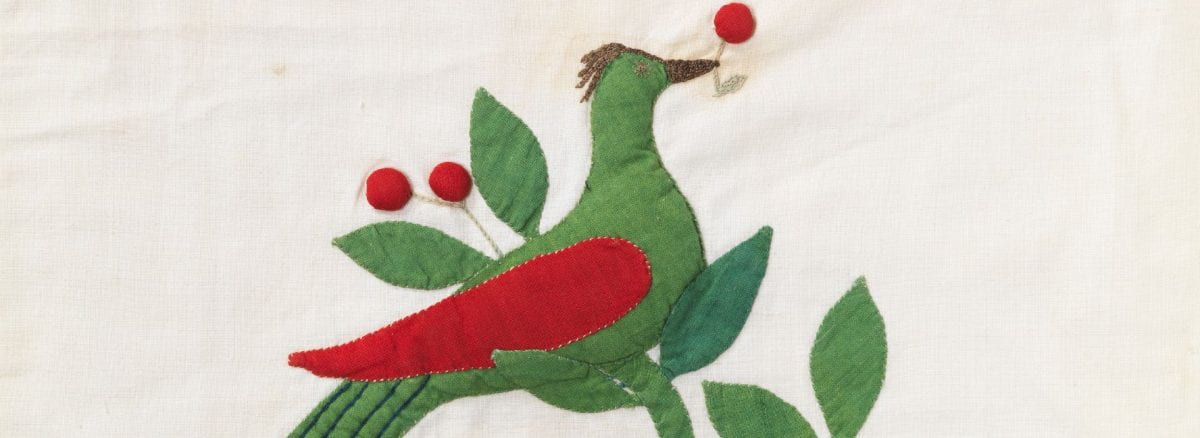This c. 1840 quilt square from the Cotsen Textile Traces Study Collection (T-1455) was never incorporated into a final quilt. As such, it is considered an orphan.[i] However, the quilt square’s colors, style and motif hint that its maker may have intended to incorporate the square into an album quilt, a quilt style popular in the United States from 1840-1860.[ii] Album quilts are composed of multiple quilt squares, each with a unique and varying design . The squares of an album quilt often contain bold red and green floral and naturalistic motifs appliquéd in a diagonal orientation on a white background. Floral motifs—whether of flower baskets, bouquets, wreaths or stylized tulips— are the most common motif found in album quilts. Many also include a square or two with animals, patriotic symbols or abstract patterns. In album quilts, these designs are usually appliquéd, assembled from pieces of fabric and then applied to a ground with stitching.

Although the squares for an album quilt could be made by a single person, they were often made by a group of women connected through friendship, familial, religious or other community ties. Each woman from the group would contribute a square to include in a quilt that would be gifted to commemorate a significant event in the life of the recipient, such as a marriage, a birthday, the birth of a child or a move. As such, each square of an album quilt is unique and displays the skill and personality of the individual who made it. Yet because album quilts were made by groups of women who lived in the same community, many regions developed distinct album quilt styles. One of the most distinct and well-known of these is the Baltimore album quilt. Baltimore album quilts employ fabric selection and quilting techniques to give the design of the squares depth and dimension. This is very different from the flatter style employed in the Cotsen quilt square.

Style attribution is one way to trace the potential place where an album quilt was made. However, some album quilts contain the signatures of the women who made each square. This information can prove invaluable in locating both the community and makers of an album quilt. Quilts with signatures are known as signature quilts and are sometimes also referred to as friendship quilts. Indeed, this genre of quilts—whether referred to as an album, signature, or friendship quilt—is part of a Victorian culture that emphasized friendship and sentimentality. The quilts can be seen as textile versions of paper albums kept by girls and women that contained various paraphernalia (drawings, poetry, and signatures) from friends.[iii] The Cotsen quilt square is unsigned and the name of the maker is unknown, as is the story of why the square was made. However, its design hints that it was meant to be part of an album quilt. A closer look at the square reveals unique details about its construction.

The maker of the Cotsen quilt square chose a bird as her quilt square motif. She cut out nineteen pieces to compose her design and secured them using stitches of white thread. She supplemented her design by stuffing the bird and berries. She further added to the design by using a variety of thread colors to hand-embroider the beak, eye and plumage for the bird, in addition to stems for the berries. A tiny blue thread at the bird’s shoulder wraps around the back of the quilt and emerges at the breast of the bird, where it has been used to fully secure the design to a leaf made from a different fabric than the other leaves in the square. The construction of this section of the design differs from the rest and suggests the quilt may have been patched at one point.

The patching provides a potential clue about why this quilt was orphaned. Perhaps the stuffing burst years after the square was finished, necessitating patching. Or perhaps the patching happened soon after the square was made, and this is the reason it was orphaned. Or perhaps, the square was a practice square and simply did not fit in with the final design of the album quilt. While we will most likely never know why this quilt square was ultimately left out of a final quilt, we can see the square was composed and cared for with detail and attention. For other examples of album quilts, check out the International Quilt Museum, the American Folk Art Museum, the Quilt Index, and the National Quilt Collection at National Museum of American History.
Notes
[i] Maloney, Tricia Lynn. Orphan Block Quilts: Making a Home for Antique, Vintage, Collectible and Leftover Quilt Blocks. Cincinnati, Ohio: Krause Publications, 2010.
[i] Baumgarten, Linda, and Kimberly Smith Ivey. Four Centuries of Quilts: The Colonial Williamsburg Collection. Williamsburg, Virginia: The Colonial Williamsburg Foundation, 2014.; Kiracofe, Roderick. The American Quilt: A History of Cloth and Comfort, 1750-1950. New York: Clarkson Potter, 1993.; Peck, Amelia. American Quilts & Coverlets in the Metropolitan Museum of Art. Metropolitan Museum of Art, 1990.
[ii] Hunt, Katherine A. “From the Collection: The Emlen‐Williams Quilt, 1851.” Winterthur Portfolio 41, no. 1 (March 2007): 43–52. https://doi.org/10.1086/511406.
